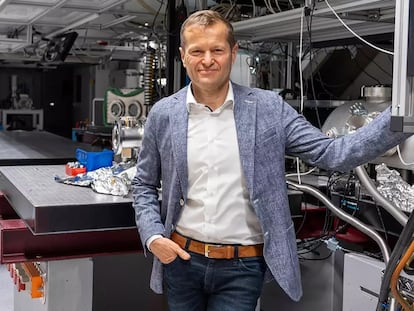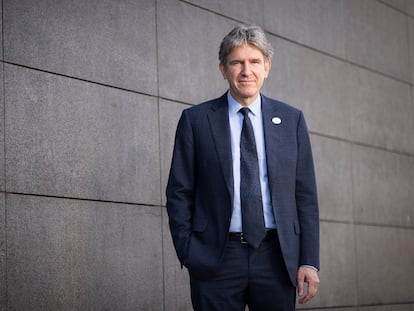Joan Massagué: ‘Metastasis is no longer a death sentence. In some cases, it is curable and we are learning to prevent it’
The Spanish researcher, director of the Memorial Sloan Kettering Cancer Center in New York, explains the recent advances that are bringing us closer to turning cancer into a chronic disease


Joan Massagué, 70, says that a great change is taking place in science’s ongoing battle against cancer. New research into metastasis has led to a leap of knowledge that is so great it is modifying our relationship with this dark and deadly disease. Metastasis is no longer something we try to detain with aggressive chemotherapies. New experimental drugs have been discovered that prevent it, revealing latent cells that can remain hidden for years after an apparently successful first treatment.
By teaching the immune system to identify these sleeping cancer cells, we can prevent them from overcoming our defenses and causing metastasis to return with increasing force, which is what happens in cancers such as lung cancer. Given the enormous difficulty of containing these recurrent relapses, Massagué chose to direct the efforts of his research group into preventing, not treating metastasis. He explained this to EL PAÍS after speaking at the Spanish Cancer Research Association (Aseica) congress in November.
Massagué believes that in 20 years’ time we will be able to control cancer, just as we managed to stop infectious diseases in the mid-20th century. The Spanish scientist is one of the leaders in this fight: he directs one of the most cutting-edge centers in the world in metastasis research, the Memorial Sloan Kettering Cancer Center in New York.
Question. What are the latest advances that science has achieved in its battle against cancer?
Answer. In 2012, after more than 10 years studying the most aggressive metastasis, I decided to change course, orient the laboratory more towards latent, invisible metastasis. I came to the conviction that this is the stage of metastasis that is most worth studying. Not because it is darker, but because understanding it in its details will provide us with new avenues, new opportunities to prevent metastasis — not treat it.
Q. What is the difference between treating and preventing metastasis?
A. Treating the metastasis when it appears has been made possible; and increasingly so, thanks to personalized, high-precision therapies and immunotherapy. All of them can treat metastatic disease, although they were not designed specifically for that purpose. And what’s the result? Metastases are reduced and even disappear; or seem to disappear, because then the patient relapses.
That's why we thought about focusing on the metastasis that is not seen, the latent one. When a tumor is diagnosed and operated on, the area is then irradiated in case there is any residue left. If everything goes well, the doctor tells us that there are no sources of metastasis. Oh, that's great, that's it, right? No, it's not. There are no foci, but there may be seeds of metastasis, which the tumor had had time to spread already at the time of diagnosis.
And we also saw that when the metastasis forms, it is treated and the patient responds well to therapy. But the microscopic residue that remains is also the seed for a recurrence, for a more accelerated relapse. Relapse occurs faster after metastasis than after the primary tumor. That is why we must go beyond treating it: we must prevent it, to finish it off, eliminating these microscopic and latent residues. This is what my research group is dedicated to, and most of the advances we have published have been defining the general framework of knowledge of latent metastasis. And then, we have continued the process looking for those details that new therapies can exploit.
Q. What phase are you in of this project to prevent metastases?
A. The process is going well. Things never go as fast as one would like, but we are light years away in terms of where we were in our knowledge of dormant metastasis only 10 years ago, which is a very short time in the framework of medical research’s fight against cancer. We begin by identifying these latent cells, their properties and vulnerabilities, their relationship with the body’s defenses that are around them all the time. How come they don’t eliminate them? And our latest article, published a few months ago in the journal Nature, demonstrates that having identified how latent metastasis is evading immunity, we can use an existing drug to make it more visible to our immune system, so that we can eliminate it.
Q. But that feat was achieved in mice. Is there a risk of creating false hopes?
A. There are always cynics who say, “well, these researchers have cured cancer in mice a thousand times over.” Yes, that’s true, but when we manage to cure cancer in humans, it is because a research group cured it first in a mouse. The article is published in a prominent scientific journal because it demonstrates that “Yes, we can.” If we can delve deeper into metastasis, understand the aspects that we saw were going to be of value, we can develop a drug (or apply an existing one) to clean mouse tissues that contain latent metastasis of human cells. This had not been done before.
Q. It is surprising that your discovery can take advantage of existing drugs.
A. It is an immunotherapy drug, which makes these cells more visible to the immune system, it marks them. They hide from the immune system while they are latent, and in humans they can go unnoticed for years, until they take advantage of a mishap in the immune’s system. Those cells, which are hidden, are constantly trying and failing. Because when they try and begin to divide, they do become visible to the immune system, which continuously eliminates them. Until one of those cells sneaks in because the immune system was a little depressed, or because of other things that are also being studied.
This drug was developed for cancer, but for completely different situations. Time will tell if it is effective in preventing metastasis in humans, if someone is dedicated to doing the clinical tests, which are complicated because it involves patients who will spend a long time without developing cancer. And then, we will have to see if less metastasis develops in the treated group than in the other. For these trials to be viable, they must target cancers that have a latency period, but one that is short enough for a clinical researcher to observe the drug’s effectiveness.
Q. Like lung cancer? In lung patients with metastases, it is common for the disease to return a few months after a treatment that seemed to have worked.
A. That’s why we work in the lungs, because they do have that latency. That is the key to preventing metastasis, to preventing it from returning quickly and with increasing strength.
Q. Would that lead to a situation in which metastasis is no longer a death sentence for these patients?
A. Metastasis is no longer a death sentence, it is manageable. In some cases, it is curable with immunotherapy, and in many cases it can become chronic and we are even learning how to prevent it. It is changing our emotional and intellectual relationship with cancer, including metastasis. We are normalizing this disease. We are never going to eliminate it, just as we are never going to eliminate aging or its ailments. But we are changing our relationship with it, by understanding it enough to cure it more, make it more chronic, predict it more and prevent it more. That’s what we think should be the norm in a major disease.
We are in the second of four decades of a campaign to fend off cancer. We have 20 more years until we get it under control like we did with infectious diseases in the mid-20th century. We did not eliminate them — we just had a pandemic — but it’s not the same situation.

Q. Looking back, 30 years ago we only had chemotherapy and radiotherapy. Now we have many more therapies and we are talking about preventing metastasis. What has changed?
A. It is always knowledge. Once you understand the enemy, you can develop or apply weapons. That is why there are more and more weapons against cancer. Some with glorified names, like liquid biopsy: that technology is wonderful, yes, but it is no stranger than a blood test, only it includes markers to early detect tumors such as prostate cancer.
Q. Speaking of early detection, will we ever have the equivalent of mammography for lung cancer?
A. Yes. And for pancreatic cancer and many others. It is a very broad field, with enormous interest, because it will be a great advance for humanity. And it doesn’t have to be expensive. What’s more, it would be a huge benefit for the company that has the talent to get it out effectively and economically. In other words, so that healthcare systems can introduce it overnight, almost literally, just as the Covid-19 vaccines were rolled out.
These early detection tests will be part of the annual check-up that we all have to do from a certain age. But that age will not be 50 or 60. I would say that it will be 25 or 30 years old. If there is an affordable technology that can early detect cancers that are going to occur in the population in one in every 500 people, it will be worth the investment to check everyone. The financial savings in treatments will be enormous, in addition to the emotional and personal cost.
Q. When is widespread early detection of cancer going to be a reality?
A. It is an ideal to which we aspire. I am very good at making predictions about the past, but not predictions about the future. I don’t know. This much I do know: we are at the point in the history of science when we are turning a dark and deadly thing, such as cancer, into a medically normal disease.
Q. Can the success of Covid-19 vaccines boost the development of cancer vaccines?
A. The same technology used in Covid-19 vaccines is already being used to develop vaccines to prevent metastasis, with promising initial trials in small groups of patients. This is led by researchers at my institution [Memorial Sloan Kettering Cancer Center], who have published a series of articles in Nature that brings together evidence that it can be done. And now the trials are moving to Phase 2, with 200 patients from about 80 international centers; including some in Spain, who are currently preparing to participate.
The success of the Covid-19 vaccines has increased confidence in that [messenger RNA] technology. However, my colleagues had already thought about applying it to prevent metastasis from pancreatic cancer. Now we have the advantage that there is experience in how to manufacture and administer these vaccines on a large scale. What’s more, pharmaceutical companies have the ability to take risks in new applications of their vaccines, because they have been able to make important profits that encourage them to launch into new challenges. And that is cause for hope. Of course, nothing comes fast enough for the cancer patient who needs it today. But they can also think: “They have done more for me today and treated me better than they would have 10 or 20 years ago.”
Q. What do we know about cancer today that we didn’t know 20 years ago?
A. Cancer is the end of a movie in which the good guys lose, after an epic battle between the mutations that have been growing in the living being and the vigilance of the immune system that a person’s defenses have developed to eliminate them. Mutations are an absolutely necessary condition for cancer, but completely insufficient. A cell that has mutated until it is capable of forming a tumor has a very difficult time achieving this. Every day we generate hundreds or thousands of these precancerous cells, but our immune system eliminates or incapacitates them.
They have it very difficult, they constantly fail. But we are giving them tickets to win the lottery (and the tumor appears), when we subject the body to behaviors that create chronic inflammation. Inflammation causes a disruption in the immune system. It accelerates tissue regeneration because the tissue is stressed and encourages cells to want to divide [which is what tumor cells do, at high speed]. Today we know that tobacco and pollution cause more cancer through the chronic inflammation they cause than due to the mutations they generate.
Q. What habits in our daily lives make it easier for these malignant cells?
A. In addition to tobacco and pollution, excessive alcohol, which puts a constant inflammatory load on the liver and pancreas. Or aggressive and very salty foods, which stress and irritate the stomach. When you irritate and inflame, you are weakening your immunity because inflammation is an arm of immunity: when you force that arm, you throw everything off-balance. Inflammation is the cradle for these cells with mutations to develop, which will happen no matter what we do. And if we smoke, if we expose ourselves to the sun, even more will emerge.
Sign up for our weekly newsletter to get more English-language news coverage from EL PAÍS USA Edition
Tu suscripción se está usando en otro dispositivo
¿Quieres añadir otro usuario a tu suscripción?
Si continúas leyendo en este dispositivo, no se podrá leer en el otro.
FlechaTu suscripción se está usando en otro dispositivo y solo puedes acceder a EL PAÍS desde un dispositivo a la vez.
Si quieres compartir tu cuenta, cambia tu suscripción a la modalidad Premium, así podrás añadir otro usuario. Cada uno accederá con su propia cuenta de email, lo que os permitirá personalizar vuestra experiencia en EL PAÍS.
¿Tienes una suscripción de empresa? Accede aquí para contratar más cuentas.
En el caso de no saber quién está usando tu cuenta, te recomendamos cambiar tu contraseña aquí.
Si decides continuar compartiendo tu cuenta, este mensaje se mostrará en tu dispositivo y en el de la otra persona que está usando tu cuenta de forma indefinida, afectando a tu experiencia de lectura. Puedes consultar aquí los términos y condiciones de la suscripción digital.
More information
Archived In
Últimas noticias
‘Fallout’ or how the world’s largest company turned an anti-capitalist apocalyptic Western into a phenomenon
From inflation to defending migrants: Eileen Higgins and Zohran Mamdani inaugurate the new Democratic resistance against Trump
EU’s prestige at stake with proposal to fund Ukrainian war effort with Russian assets
Mustafa Suleyman: ‘Controlling AI is the challenge of our time’
Most viewed
- ‘El Limones’ and the growing union disguise of Mexican organized crime
- Christian Louboutin: ‘Young people don’t want to be like their parents. And if their parents wear sneakers, they’re going to look for something else’
- ‘We are dying’: Cuba sinks into a health crisis amid medicine shortages and misdiagnosis
- The low-cost creative revolution: How technology is making art accessible to everyone
- A mountaineer, accused of manslaughter for the death of his partner during a climb: He silenced his phone and refused a helicopter rescue










































